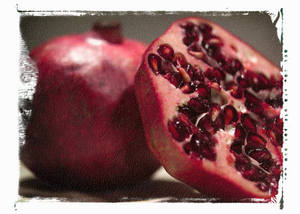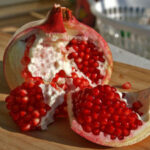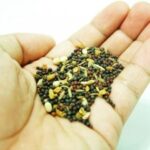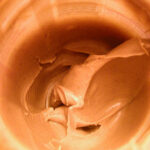The pomegranate, or Punica granatum L., is in the Punicaceae family. The ancient fruit grows around the world in warm climates. From jellies to juices, households worldwide enjoy this healthy fruit. However, few American kitchens give the misunderstood pomegranate its due.
Pomegranates are known by a variety of names, including granada, grenadine. (Yes, the grenadine syrup that is commonly used in drink recipes is made from pomegranates.) They are the size of a large orange with a leathery exterior. The inside of pomegranates houses a white membrane and hundreds of seeds. The seeds, the edible part of the fruit, have a sweet-tart taste and release juice when you bite into them or crush them. (The white membrane is often used in skin care products.)
Fresh pomegranates are available in the USA from September to January. They store well if kept in a cool, dark place. The seeds can be frozen for up to three months.
The red and delicious pomegranate is an underrated food. The fruit has many health benefits, including antioxidant properties. WebMD Medical News says they are good for your heart. One of the most popular pomegranate juice makers, POM Wonderful, points out that its pomegranate juice has plenty of polyphenols to keep your insides young.
There are several ways to eat a pomegranate. The first is to slice it and bite into the seeds. The Pomegranate Council, however, has a different way. It recommends that you first remove the stem. Then, cut the pomegranate into sections, and soak them in a bowl of water for at least five minutes. Gently remove the seeds by running your fingers through the pieces. Discard the rind and white membrane. Drain the seeds, and pat dry. From here, the uses are many.
Pomegranate seeds can be eaten as is, used in recipes, or consumed as juice. Some prefer to use the seeds as a garnish. Although there is a bit of controversy over whether or not to eat the seeds, consider that they are the prime source of fiber from the fruit.
Whether you prefer pomegranates in juice form or not, there are plenty of recipes using the versatile fruit. Why not give this recipe for “Cucumber and Pomegranate Salad” from the Pomegranate Council a try:
1/2 cup chopped scallions
1/2 cup chopped fresh mint or 1 tablespoon dried mint
1 teaspoon salt
1/2 teaspoon ground pepper
1/2 teaspoon angelica powder
1 long seedless cucumber, peeled and diced
Seeds of 2 pomegranates
1 fresh lime, peeled and sliced, with inner skin removed
In serving bowl, combine ingredients and mix thoroughly. Season to taste with salt.
*Recipe ©Pomegranate Council
So, the next time you’re looking for something different, be sure to include pomegranates on your list. You will not be disappointed!
Sources:
WebMD Medical News, “Pomegranate Juice May Clear Clogged Arteries” URL: http://www.webmd.com/food-recipes/news/20050321/pomegranate-juice-may-clear-clogged-arteries Accessed June 17, 2007
Pomegranate Council, “No Mess” URL: http://www.pomegranates.org/nomess.html Accessed June 17, 2007
POM Wonderful, “Aging – Emerging Science” URL: http://www.pomwonderful.com/aging.html Accessed June 17, 2007






